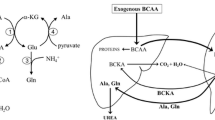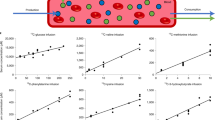Abstract
The effects of starvation on the concentration of blood and tissue metabolites was determined at different times in rats starved up to 6 days.
The concentration of the hepatic gluconeogenic intermediates: pyruvate, phosphoenolpyruvate, 2-phosphoglycerate and 3-phosphoglycerate, decreased by 50% by the third day and then gradually increased to control levels by the sixth day of starvation. The change in the concentration of these metabolites correlates inversely with the plasma free fatty acid levels and the β-hydroxybutyrate: acetoacetate (B/A) ratios, suggesting that the increased generation of reducing equivalents from free fatty acid oxidation stimulate glyceraldehyde-phosphate dehydrogenase. However, this apparent stimulation does not appear to control glyconeogenic flux. The concentration of hepatic oxaloacetate increased gradually during starvation and correlated closely with the increase in hepatic gluconeogenic flux suggesting that the hepatic concentration of oxaloacetate may be important in controlling the rate of hepatic gluconeogenesis.
The calculated equilibrium expression: [alanine] [α-ketoglutarate]/[pyruvate] [glutamate] and [aspartate] [α-ketoglutarate]/[oxdaloacetate] [glutamate] for alanine aminotransferase and aspartate amino transferase respectively, remained fairly constant in all the tissues studied throughout the starvation period, despite large changes in the concentrations of the individual reactants, indicating that these reactions are near equilibrium.
The β-hydroxybutyrate: acetoacetate (B/A) ratios, taken to reflect the mitochondrial redox state, increased more than 4-fold in liver and muscle after the first day of starvation. It decreased after the third day of starvation and returned close to prefasting levels by the sixth day. The change in B/A ratios in blood was similar to those observed in the organs, except that the magnitude of the change was less. The changes observed in the mitochondrial redox state during starvation correlate closely with the changes in plasma free fatty acid concentrations and with the rate of fatty acid oxidation.
Similar content being viewed by others
References
Brosman, J. T., Krebs, H. A., Williamson, D. H.: Effects of ischemia on metabolite concentrations in rat liver. Biochem. J.117, 91–96 (1970)
Felig, P., Wahren, J.: Amino acid metabolism in exercising, man. J. Clin. Invest.50, 2703–2714 (1971)
Herrera, E., Freinkel, N.: Interrelationships between liver-composition, plasma glucose and ketones, and hepatic acetyl-CoA and citric acid during prolonged starvation in the male rat. Biochim. Biophys. Acta170, 244–253 (1968)
Krebs, H. A.: Equilibria in transaminase systems. Biochem. J.54, 82–86 (1953)
Krebs, H. A.: Pyridine nucleotides and rate control. In: Rate control of biological processes, pp. 299–318 (Davies, D. D., ed.). Cambridge: University Press 1973
Krebs, H. A., Freedland, R. A., Hems, R., Stubbs, M.: Inhibition of hepatic gluconeogenesis by ethanol. Biochem. J.112, 117–124 (1969)
Parrilla, R.: Flux metabolic fuels during starvation in the rat. Pflügers Arch.374, 3–7 (1978)
Parrilla, R., Goodman, M. N.: Nitrogen metabolism in the isolated perfused rat liver. Nitrogen balance, redox state and rates of proteolysis. Biochem. J.138, 341–348 (1974)
Parrilla, R., Ayuso-Parrilla, M. S., Goodman, M. N.: Determination of someL-amino acids in biological samples by aminoacylation of tRNA. Anal. Biochem.54, 362–369 (1973)
Parrilla, R., Jimenez, M. I., Ayuso-Parrilla, M. S.: Cellular-redistribution of metabolites during glucagon and insulin control of gluconeogenesis in the isolated perfused rat liver. Arch. Biochem. Biophys.174, 1–12 (1976)
Parrilla, R., Toews, C. J., Cahill, G. F.: Lack of nitrogen sparing in the fasted rat. Endocrinology88, Suppl. 57 (1971)
Williamson, J. R.: General features of metabolic control as applied to the erythrocyte in red cell metabolism and function, pp. 117–136 (Brewer, G. J., ed.). New York: Plenum 1970
Williamson, J. R., Browning, E. T., Scholz, R.: Control mechanisms of gluconeogenesis and ketogenesis. I. Effects of oleate on gluconeogenesis in perfused rat liver. J. Biol. Chem.244, 4607–4616 (1969)
Williamson, D. H., Mellanby, J., Krebs, H.: Enzymatic determination ofD()-β-hydroxybutyric acid and acetoacetic-acid in blood. Biochem. J.82, 90–96 (1962)
Wisonoff, A., Barnes, F. W., Jr., Enns, T.: Mechanisms in enzymatic transamination: estimation of velocity of the glutamateaspartate reaction ar equilibrium. J. Biol. Chem.204, 957–969 (1953)
Author information
Authors and Affiliations
Rights and permissions
About this article
Cite this article
Parrilla, R. The effect of starvation in the rat on metabolite concentrations in blood, liver and skeletal muscle. Pflügers Arch. 374, 9–14 (1978). https://doi.org/10.1007/BF00585691
Received:
Issue Date:
DOI: https://doi.org/10.1007/BF00585691




